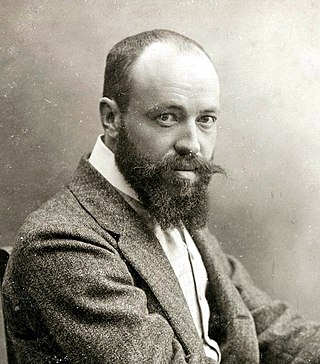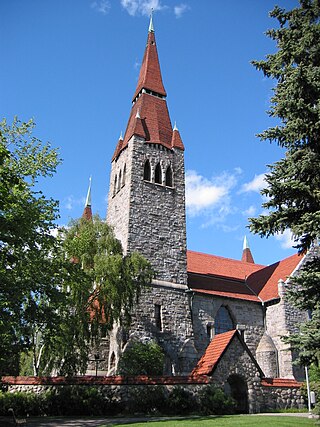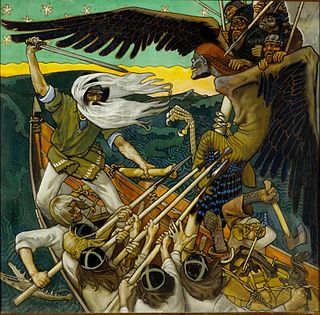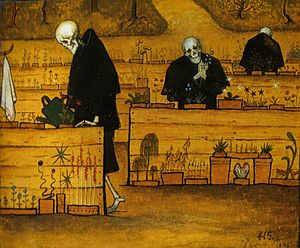
Symbolism was a late 19th-century art movement of French and Belgian origin in poetry and other arts seeking to represent absolute truths symbolically through language and metaphorical images, mainly as a reaction against naturalism and realism.

Akseli Gallen-Kallela was a Finnish painter who is best known for his illustrations of the Kalevala, the Finnish national epic. His work is considered a very important aspect of the Finnish national identity. He finnicized his name from Gallén to Gallen-Kallela in 1907.

Hugo Gerhard Simberg was a Finnish symbolist painter and graphic artist.

Lemminkäinen or Lemminki is a prominent figure in Finnish mythology. He is one of the heroes of the Kalevala, where his character is a composite of several separate heroes of oral poetry. He is usually depicted as young and good-looking, with wavy red hair.

Jorma Gallen-Kallela was a Finnish artist. He followed in the footsteps of his father, the famed artist Akseli Gallen-Kallela.

Giovanni Segantini was an Italian painter known for his large pastoral landscapes of the Alps. He was one of the most famous artists in Europe in the late 19th century, and his paintings were collected by major museums. In later life, he combined a Divisionist painting style with Symbolist images of nature. He was active in Switzerland during the last period of his life.

Ateneum is an art museum in Helsinki, Finland and one of the three museums forming the Finnish National Gallery. It is located in the centre of Helsinki on the south side of Rautatientori square close to Helsinki Central railway station. It has the biggest collections of classical art in Finland. Before 1991 the Ateneum building also housed the Finnish Academy of Fine Arts and University of Art and Design Helsinki.

Pehr Louis Sparre af Söfdeborg was a Swedish painter, designer and draughtsman, most noted for his early work in the Finnish national romanticism and jugend styles. He also competed in the individual and team épée fencing events at the 1912 Summer Olympics.

Finnish National Gallery is the largest art museum institution of Finland. It consists of the Ateneum, an art museum; Kiasma, a contemporary art museum; and the Sinebrychoff Art Museum, a historic house and art museum.

Tampere Cathedral is a Lutheran church in Tampere, Finland, and the seat of the Diocese of Tampere. The building was designed in the National Romantic style by Lars Sonck, and built between 1902 and 1907.

The Wounded Angel is a painting by Finnish symbolist painter Hugo Simberg. It is one of the most recognizable of Simberg's works, and was voted Finland's "national painting" in a vote held by the Ateneum art museum in 2006. In a similar 2013 vote held by Nordic Moneta, it was voted second most important.

The Defense of the Sampo is a tempera-on-canvas Romantic national painting created in 1896 by Finnish painter Akseli Gallen-Kallela. The painting illustrates a passage from the Kalevala, the Finnish national epic compiled by Elias Lönnrot in the 19th century.

Carl Johan Bengts was a Finnish-Swedish painter in the Modernist style who specialized in rural themes.

Finnish art started to form its individual characteristics in the 19th century, when romantic nationalism began to rise in the autonomous Grand Duchy of Finland.

Hilda Flodin was a Finnish artist. She worked in a variety of media, but in the first part of her career primarily sculpture and etchings, later primarily painting, especially portraits.

Kullervo Sets Off for War is a painting by Akseli Gallen-Kallela from the year 1901. He painted the subject in tempera painting and as a fresco which is located in the music hall of Old Student House of Helsinki University.

Janne Sirén is a Finnish art historian and the Peggy Pierce Elfvin Director of the Buffalo AKG Art Museum, formerly known as the Albright–Knox Art Gallery in Buffalo, New York. Before joining the Buffalo AKG Art Museum, Sirén served as Director and City of Helsinki Department Chief at the Helsinki Art Museum from 2007 to 2013. Prior to that, he served as Director of the Tampere Art Museum from 2004 to 2007.

Symbolist painting was one of the main artistic manifestations of symbolism, a cultural movement that emerged at the end of the 19th century in France and developed in several European countries. The beginning of this current was in poetry, especially thanks to the impact of The Flowers of Evil by Charles Baudelaire (1868), which powerfully influenced a generation of young poets including Paul Verlaine, Stéphane Mallarmé and Arthur Rimbaud. The term "symbolism" was coined by Jean Moréas in a literary manifesto published in Le Figaro in 1886. The aesthetic premises of Symbolism moved from poetry to other arts, especially painting, sculpture, music and theater. The chronology of this style is difficult to establish: the peak is between 1885 and 1905, but already in the 1860s there were works pointing to symbolism, while its culmination can be established at the beginning of the First World War.

Symposium is an oil painting created by Akseli Gallen-Kallela in 1894.




















